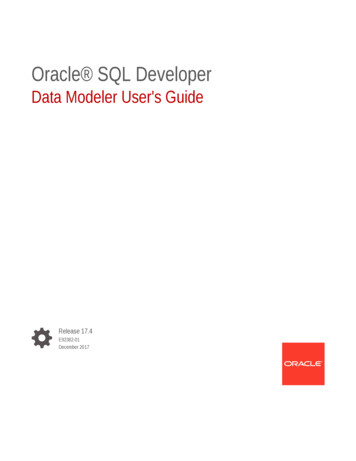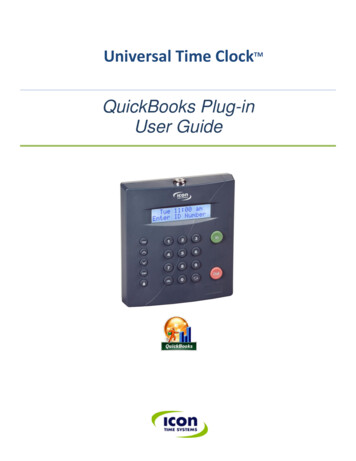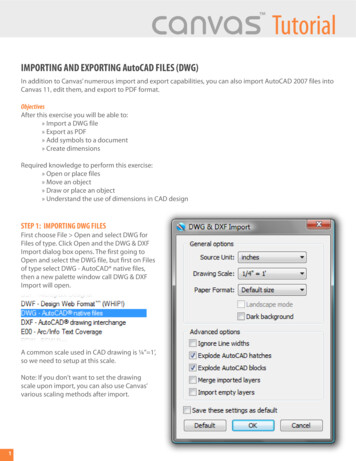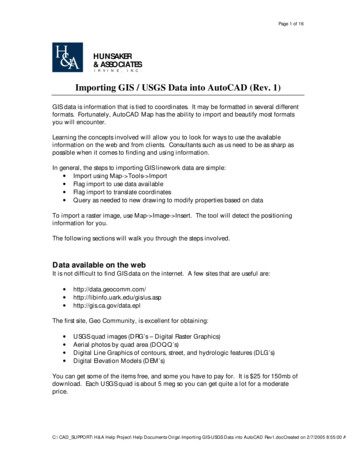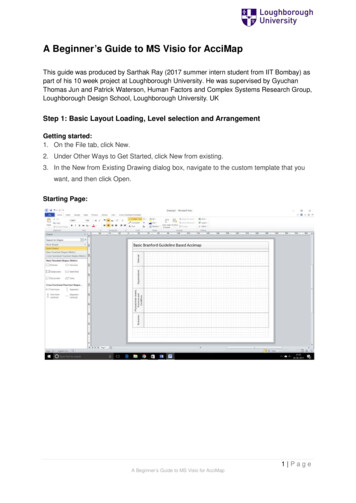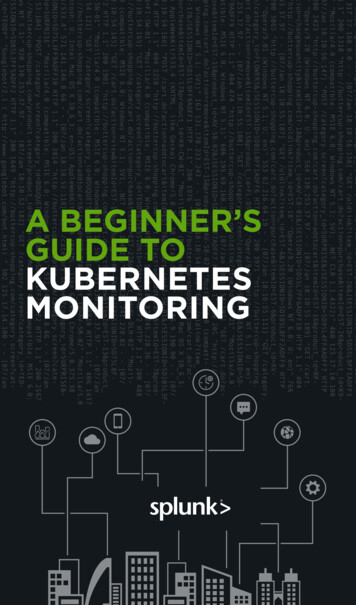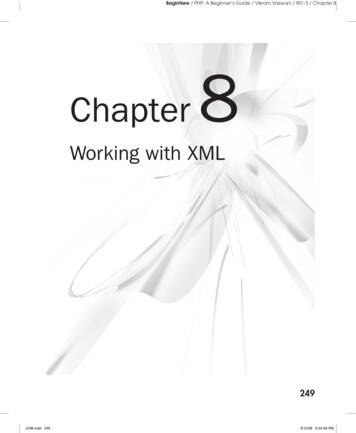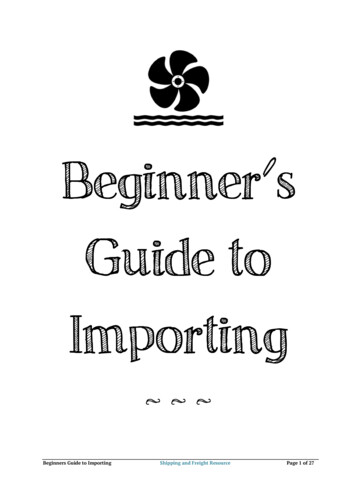
Transcription
Beginner sGuide toImporting Beginners Guide to ImportingShipping and Freight ResourcePage 1 of 27
Importing The act of bringing cargo into a countryfrom another country, using legal means,for the purpose of selling, trading or localconsumptionBeginners Guide to ImportingShipping and Freight ResourcePage 2 of 27
Table of ContentsSection 1Why did I write this guideWho will benefit from this guide44Section 2How to use this guideTerms of Use & DisclaimerTerms of UseDisclaimer5556Section 3Chapter 1 - Do your homeworkChapter 2 - Identify your sourcesChapter 3 - Terms of saleChapter 4 - Understand the import processChapter 5 - Service providersChapter 6 - Get involvedChapter 7 - Safeguard yourselfChapter 8 – Summary79111417192225Section 4About the AuthorBeginners Guide to Importing27Shipping and Freight ResourcePage 3 of 27
Why did I write this guide?There are several people who enter the trading business without properinitiation, training, knowledge or research. This has led to severallosses, closures and unnecessary heartache.My motto has always been SEEK . LEARN . KNOW . GROW and in linewith this motto, I wrote this guide to assist those who are interested inunderstanding and learning the process of how import works and applythat knowledge to their business and hopefully avoid aforementioneddisasters.Who will benefit from this guide?This guide is recommended for first time importers, regular importers,traders, entrepreneurs, freight forwarders and trade financiers.If your niche is in Growing your import business Developing new import markets Financing import businesses Handling import businessesthen this guide is for you.Credits : I have used images from various artists from Noun Project in thepreparation of this guide.Beginners Guide to ImportingShipping and Freight ResourcePage 4 of 27
How to use this guide?Each Chapter in this guide maybe considered as a standalone “guidewithin a guide” that can be read in isolation but it also links to the nextChapter.In order to get a full understanding of the subject, it is recommendedthat you read it all the way through, at least once, and then it may beused as a reference guide as and when needed.Terms of Use & DisclaimerTerms of UseI have spent a lot of time and effort to write this guide. So please respectthat and don’t use any of this content in part or in full or in any form byany means (electronic, photocopying, recording or otherwise) for anycommercial purposes without my consent. A simple email to me will do.The copyright and other intellectual property rights of all material on thisguide are owned by me.All rights reserved. Copyright 2016 Hariesh Manaadiar (Puthan House) /Shipping and Freight ResourceBeginners Guide to ImportingShipping and Freight ResourcePage 5 of 27
DisclaimerI have written this guide from my experience and knowledge gained onthe job since 1989, so if there is some stuff that you don’t agree with,please do let me know. But after using what I have written (with mypermission of course), you can’t hold me responsible for anything.The intention of this guide is to provide guidance to first time importersfor information and educational purpose only and is not offered as legaladvice or legal opinion. If you require legal advice or opinion, specialistadvice should be sought about your specific circumstances.I have taken all reasonable steps to ensure that the information on thisguide is correct and current. However, this guide’s information isdynamic and information that is published today might not be valid oraccurate two days or two years from now.Content, sources, information and links change all the time, and it is theresponsibility of the user to verify the contents of this guide in relation toabove.Neither the author nor any other party (whether or not involved inproducing, maintaining or delivering this guide), shall be liable orresponsible for any kind of loss or damage as a result of the use of thisguide and the information provided herein.This exclusion shall include direct, incidental, consequential, indirect orpunitive damages arising out of access to or use of any content on thisguide regardless of the accuracy or completeness of any such content.Beginners Guide to ImportingShipping and Freight ResourcePage 6 of 27
Chapter 1 - Do your homeworkYou should havedone your homeworkBEFOREyou started.!!!!!BEFORE you enter into the business of imports, do your homework. Askyourself the below key questions:Why, When, What, Who & How1) Identify and understand why you want to import. General reasonswhy people import are:a) For the purpose of trading either domestically or further on toneighbouring countriesb) To create and develop a market in their country for a nicheproduct. For example, some entrepreneur may sense a gap inthe market for a niche product (like a brand of cell phone or haircare product) and might choose to import this product anddevelop it in their country.c) For own consumption. Like raw materials for yourmanufacturing plantBeginners Guide to ImportingShipping and Freight ResourcePage 7 of 27
In all these cases you need to be aware of the formalities required for theimport and further movement of the specific product(s).2) Identify and know when you should import your cargo. For example,don’t bring in summer clothes at the start of winter, or Christmasdecorations, toys etc after the festive season. Timing your import isan absolute necessity for your business to be successful.3) Identify what you want to import. Ascertain physically andpersonally whether the product that you want to import will sell inyour market or not. There is no point in importing somethingbecause it is a niche product, but there is no market in your countryfor this product.4) Identify who you should import the product from. Check whether theseller is a reliable company or person with a proven track record.5) Identify how you should import the product and in what quantities.You need to understand whether the product should be imported inbig volumes (like in full containers) or smaller volumes (like LCLcargo) and whether the import should be via sea freight or air freight.After you have asked and answered above questions to yourself, you shouldproceed to the next step which is to identify your sources.Beginners Guide to ImportingShipping and Freight ResourcePage 8 of 27
Chapter 2 - Identify your sourcesOk, you have done all of the above personally and identified that yourcargo can in fact be imported. What next.The next big step would be to identify your supplier.How do you identify your supplier.? There are several sources allaround the world to help you identify the suppliers that may be able tosupply the cargo that you want.Most popular among these sources are :Virtual sourcesTangible sources Trade Portals Trade Fairs/Road Shows Websites Consulates Blogs Chambers of Commerce Magazines Word of mouthWhichever options you choose, there is one thing you must do beforeyou sign on the dotted line and that is “Check the reputation andreliability of your supplier” .Beginners Guide to ImportingShipping and Freight ResourcePage 9 of 27
Some of the questions you should ask the supplier are: How long have they been in business.? Verify that the company and person that you are buying fromare genuine and actually a legal entity. Have they exported any of their products to your country.? If they have, can they give you some trade references in yourcountry, maybe an existing client.?There are many fly by night middlemen who pretend to be the supplier,manufacturer, seller etc and you will find out much later that theircompany doesn’t really exist.If the business is new, it is recommended that you pay a visit to thecompany at the origin and convince yourself that the seller and theproduct is genuine.Many an importer has lost everything because they didn’t check theseimportant items.Next comes the crucial element of understanding and choosing the Terms ofSale.Beginners Guide to ImportingShipping and Freight ResourcePage 10 of 27
Chapter 3 - Terms of saleOnce you have established that your supplier is a reliable company andyou have decided to go with them, there is bound to be some discussionsand negotiations with your seller regarding the terms of sale, paymentterms, credit terms etc etc.For your own peace of mind it is always good to enter into a salescontract with your supplier which should clearly outline : Responsible parties Responsibility of each party Agreed terms of delivery and terms of sale Agreed pricing on the product Agreed place/point of delivery e.g. Port, warehouse, Door etc Payment methods outlining whether payment would be on COD,Letter of Credit etc Any technical issues such as product licencing, permits, quotasIf it is your first time drafting a sales contract, it is highly recommendedthat you use a good contract lawyer to finalise the contract. While thismay seem as an added expense, it will be a one-time expense butsomething that will safeguard you in the future.Beginners Guide to ImportingShipping and Freight ResourcePage 11 of 27
It is recommended that you read, understand and identify the mostsuitable Incoterms for your business before you enter into discussionsand negotiations relating to your terms of sale/business.A lot of fraud, duping and mistakes happen because the buyer or sellerdidn’t understand the Incoterms to be used for a particulartransaction.It is NOT a one size fits all solution. Each sale is individual and has to betreated differently.There is nothing worse for a first time importer thanchoosing the wrong Incoterms and suffering theconsequences later.All buyers (and sellers) should own a copy of theIncoterms which can be bought online from theInternational Chamber of Commerce’s Online Store.There are several articles and practical discussions in my Shipping andFreight Resource blog relating to Incoterms which may be of assistanceto you in understanding it, but nothing beats the actual book.Beginners Guide to ImportingShipping and Freight ResourcePage 12 of 27
There are several forms of payment each with its own element of risk. Agraphical representation of the element of risk in relation to the buyerand seller is shown below.The buyer and the seller must come to an understanding on which formof payment terms suits them both and work according to that.A Letter of Credit seems to be a popular method of documentary creditamong sellers and buyers as all transactions go through a bank and thatseems to give a level of comfort for both the buyer and the seller.When in doubt, obviously consult a reliable Trade Finance consultant inyour area.Now that you have finalised the terms of sale, spend some timeunderstanding the complete process of imports.Beginners Guide to ImportingShipping and Freight ResourcePage 13 of 27
Chapter 4 - Understand the import process1. Since you want to enter into the business of importing, you NEED toknow, you HAVE to know, you WANT to know how the whole processworks.2. Don’t just be content knowing only what happens with your shipmentor business, know the whole process. This way, if something untowardhappens, you know how to handle it, who to speak to and not topanic.3. Speak to your Agent, the shipping line, and if possible Customs, Port,Chamber of Commerce to understand the various roles and how eachentity fits in the whole chain.4. Visit your local customs office tofind outa. The requirements to become animporter. Every importer willneed to register with customs intheir country and get animporter’s code (it might beBeginners Guide to ImportingShipping and Freight ResourcePage 14 of 27
called different names in different countries).b. Information whether the cargo that you want to import is allowedto be importedc. Are there are any restrictions, permits, licenses etc that mayberequiredd. Any duty or tax benefits you might be eligible for depending onyour company, product, country of purchase etce. If you plan on importing agricultural, wildlife, food products andany other exotic items, it would be wise to also check with therelevant departments (Agriculture, CITES, Health) for theprocedures for such imports.5. If you have no clue about all of the above or the inclination to getfirst-hand information, then seek the advice of a reliable customsbroker who should have all this information already or know where tofind it for you.6. But it is highly recommend that at least in the beginning stages, youvisit customs personally to find out this information first hand as thebusiness is yours and some of the customs officials might actuallyenjoy interacting with direct importers.7. Read educational blog related to shipping, freight, trading, maritimelike Shipping and Freight Resource to understand more (couldn’t resistslipping that in ) and if you don’t find answers to any specificquestion, ask the author.Ok, so now you have identified your suppliers, discussed about your cargowith customs, got their confirmation, finalised and agreed your terms ofsale and delivery and are raring to go. Not yet. You still have to identifyyour service providers.Beginners Guide to ImportingShipping and Freight ResourcePage 15 of 27
Chapter 5 - Service providersProbably one of the most crucial decisions that you will ever make interms of your business is to find a reliable service provider.“Who is a service provider and why do I need one”? I hear youasking.There are several service providers in an import process and dependingon your business and terms of your business, you may have to appointone or more of the service providers.In my opinion there are 5 key service providers that an importer may usefor their import shipment. Below table gives you the list of serviceproviders and their role and also whether their requirement ismandatory or not.This is NOT the full list of service providers involved in an import leg,but just the key ones.Beginners Guide to ImportingShipping and Freight ResourcePage 16 of 27
SERVICEROLEPROVIDERREQUIREMENTService provider used to physicallyMandatory - may beShippingmove your cargo, usually fromappointed by buyer or seller orLinePort of Load to Port of Dischargetheir agents depending on the(Carrier)but may also get involved interms of sale (Incoterms)movement from door to door.agreed uponService provider who acts as anOptional - there are severalintermediary between buyers,importers/buyers who do notFreightsellers and shipping lines whouse the services of a freightForwarderarranges the movement of cargoforwarder and deal with thefrom Point A to Point B on behalfshipping lines and otherof whoever employs them.entities directlyService provider registered withMandatory - the cargoand licenced by Customs to clearcannot be cleared throughyour cargo following the relevantcustoms without using aprocess and procedures set byregistered customs Mandatory - the cargocannot be moved from Port toService provider used to move theHauliercargo from Port of Discharge tobuyers premisesdoor without using a Haulier.Depending on the terms of salethe Haulier maybe appointedby either the buyer or theseller.Optional - a lot of the buyers3rd PartyService provider used to store theWarehouseimported goodsmay have their own warehouseso there may not be arequirement for a 3rd partywarehouseBeginners Guide to ImportingShipping and Freight ResourcePage 17 of 27
Chapter 6 - Get involvedEven though you have appointed an agent and you leave it to them totake care of all the processes, there are somethings best done by YOUpersonally.1) Follow up of your shipments either with the agent or with theshipping line or both (will also keep your agent on their toes).2) Insure Insure Insure – this is another important aspect in theentire shipping cycle that must be taken very seriously. This isYOUR cargo and you need to ensure that it is covered by insurancevia a reputed cargo insurance company with internationalcoverage or presence.Elementary you might say – but therehave been cases where people havenot insured their cargo properly orsufficiently.A transporter’s GIT is not the same as the cargo insurance that youwould take, so don’t be complacent in the belief that thetransporter’s GIT will cover your goods. It does NOT.Beginners Guide to ImportingShipping and Freight ResourcePage 18 of 27
3) There are several items you need to consider when taking out aninsurance cover. Some of them are below :a. In-transit Loss or damageb. Transit or delivery delaysc. Delays in shipment or short shipmentd. Storage due to incorrect documentatione. Dutiesf. Penaltiesg. Unloading, examination, and re-loading chargesh. Rate of Exchange fluctuations4) Make sure that you get the original insurance policy from yourbroker or insurance company and keep it safe. If anything doeshappen to your cargo, this is one of the most important documentsyou must produce to recoup your losses.5) For personal effects cargo, ensure that the packing companyprepares an inventory list of which items they are putting in whichpackage.6) They must give you that final copy which you and the packingcompany must sign as acknowledgement of what was handed overto them and in what condition. If there are any obvious externaldamages to your goods, that must be clearly highlighted.7) Establish and verify that your goods have actually been shipped.(Yes this has also happened). Ascertain and familiarise yourselfwith the route (example as shown below) that your cargo will takefrom port of load to port of final discharge, and how long it isexpected to take, especially if you are shipping your cargo as LCLBeginners Guide to ImportingShipping and Freight ResourcePage 19 of 27
and if the cargo is going to be reworked into another containeralong the way.As a service only, most shipping lines will send you/your agent anArrival Notification advising when the cargo is expected to reachyour Port of Discharge. Follow this with great care and if it doesn’treach on or around the indicated ETA you need to follow up.8) As a standard, you should receive below documents from the selleronce the shipment has been loaded on the ship : Bill of Lading – this can be either a Negotiable Bill (requiresOriginal Bill of Lading) or a Sea Waybill depending on thearrangement with your seller. Commercial Invoice Packing List Certificate of Origin Certificates such as EUR1 Permits, Carnet etc if any Sampling or analysis certificates if anyBeginners Guide to ImportingShipping and Freight ResourcePage 20 of 27
Chapter 7 - Safeguard yourselfA new importer must always pay attention to safeguarding her bestinterests. There are several importers who have gone out of businessjust after the first shipment because they didn’t safeguard themselvesadequately.Here are a dozen points to safeguard you.1)Always ensure that the service provider you appoint has therelevant credentials, experience and expertise to handle yourcargo.2)Even if you feel that they cost you a bit, this cost may be negligiblewhen considering the value of your cargo and it is in your interestthat it is safely transported, handled and delivered.3)For example, selection of a haulier is a serious process as a lot oftimes cargo goes missing or gets damaged enroute and it isimperative that the haulier you employ knows their business andalso have sufficient GIT (Goods In Transit) cover to protectthemselves (and you) against such damages.Beginners Guide to ImportingShipping and Freight ResourcePage 21 of 27
4)If you are looking to appoint a reliable FreightForwarder, you can look up ForwardersAssociations in your area, or search theinternet for “freight forwarder association” andyou might come up with some individualfreight forwarders or freight forwardernetwork.Usually a freight forwarder network willprovide you multiple options and you may beable to find a suitable and reliable forwarder.5)You can also check with Customs or Port authorities in your areafor some recommendations. They are always glad to be of help.6)After you identify the service provider it is recommended that youvet them thoroughly : Visit their website and read about them and understand theirservices Check for them in the local shipping newspapers or magazine Ask them for references that you can contact Look for any recommendations from anyone that might haveused them7)Depending on the Incoterms used, it may happen that the sellerwill be taking care of the insurance. In this case ensure that youhave the full details of the insurance policy and type of cover.8)In your best interest as importer, it is strongly recommend thatyou check the accuracy of any customs declarations made on yourbehalf by your clearing agent.Beginners Guide to ImportingShipping and Freight ResourcePage 22 of 27
Also ask your clearing agent to give you copies of all declarationsmade to customs on your behalf by them as this may be requiredfor your VAT zero rating (where applicable) and for you tocomplete the import procedures.9)In order for your interaction with the service provider to besuccessful, YOU must understand the full scope of work that youare entrusting to them and the full breakdown of their costs downto the last cent.It is prudent to go through each and every item of their quote sothat you understand the costs and there are no grey areas betweenyou and your agent at the time of payment or cargo release.10)There are always a few unscrupulous agents around that mighttake you for a ride. You are appointing them, so you are entitledto ask them to explain all charges in detail.There are many customers who have been ripped off because theydidn’t check and query the charges in advance and when they do, itis too late.11)If you wish to do any product inspections or analysis etc, especiallyif you are dealing with seller for the first time, do your ownresearch and appoint your own agent to do these activities ratherthan the shipper’s agent.There have been cases where the buyer has used the seller’s agentand has been given false information leading to loss.Beginners Guide to ImportingShipping and Freight ResourcePage 23 of 27
12)From the various messages that I have received from the readers ofmy blog, one of the major problem that the importers face seemsto be the improper consigning of the bill of lading. This incorrectconsigning of the bill of ladinga. could be due to an honest mistake caused by lack ofawareness by the shipper orb. could be due to an intention to commit fraud by the sellerc. could cause you, the importer, a big loss by way of extra costsat the port or to be paid to the shipping lineDon’t be caught out by this and ensure that the bill of lading isproperly consigned. Let me explain how this should work :Relationship with the shipperIf you know the shipperUse these termsof paymentConsign Bill ofLading as belowIssue this bill ofladingConditionCash on Delivery or mutuallyagreed credit termsYour company Your companynamenameStraight Bill of Seaway Bill ofLadingLadingMay requireoriginal to be Does notsubmittedrequirebefore release original to be(depends on submittedthe country)If you don't know theshipperLetter of CreditTo order of XYZ Bank(your bank)Negotiable Bill of LadingDefinitely requiresoriginal bill of lading tobe surrendered beforereleaseI would also recommend you to read some articles relating tosafeguarding your cargo against fraud and other dubious practices.Beginners Guide to ImportingShipping and Freight ResourcePage 24 of 27
Chapter 8 - SummaryI would like to summarise the import process which has been writtenabove with a flow chart.Import Trading Flow (Text version)1)2)3)4)5)6)Seller identifiedTerms of sale agreedForwarder appointedShipping line nominatedShipment sailsDocuments & money swappedBeginners Guide to Importing7)8)9)10)11)12)13)Line sends arrival noticeCargo cleared with customsShipment arriveLine releases cargoCargo moved to warehouseCargo unpackedBuyer receives goodsShipping and Freight ResourcePage 25 of 27
An importer, especially a first time importer musta. Do a thorough homework about the business of import and ask thevital questions of “Why, When, What, Who & How”b. Do due diligence in identifying the supplier that you will bebuying the goods fromc. Understand and know EVERYTHING about the various Terms ofSale such as Incoterms and choose the one that best suits you andyour businessd. Understand and know EVERYTHING about the process of importsand if you don’t understand, ask a competent authoritye. Do due diligence in appointing your service providers as they canmake or break your businessf. Get involved in the business personally and take care of rate andterms of sale negotiation, service provider selection and handlingprocess at least for the first few shipmentsg. Always safeguard themselves against various kinds of fraud thatare prevalent in the business of importsI hope this guide has been helpful to you.I will be releasing some other guides such as this in the near future, soplease make sure that you subscribe to my blog (for free) so that you canreceive the notifications.All the best in your endeavours and keep shipping.Hariesh ManaadiarBeginners Guide to ImportingShipping and Freight ResourcePage 26 of 27
About the authorHello all, I am Hariesh Manaadiar the author of this Beginner’s Guide toImporting.I have been in the dynamic shipping andfreight industry for over a quarter of acentury and worked in several sectors ofthe industry like clearing & forwarding,vessel operations, stowage planning,equipment control, sales and marketingand management, in various countries.Knowing that the shipping and freightbusiness is a hard enough business tounderstand and cope, even for seasonedveterans, I started a blog called Shippingand Freight Resource to make it easy andless scary (trust me, I know the feeling)for people who are new to the industry or want to join the industry.You can also engage with me on these social media platforms.Hariesh ManaadiarBeginners Guide to ImportingShipping and Freight ResourcePage 27 of 27
Beginners Guide to Importing Shipping and Freight Resource Page 14 of 27 Chapter 4 - Understand the import process 1. Since you want to enter into the business of importing, you NEED to know, you HAVE to know, you WANT to know how the whole process works. 2. Don't just be content knowing only what happens with your shipment
